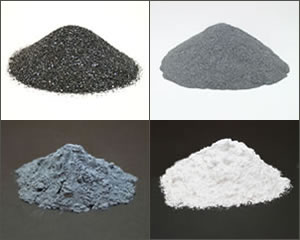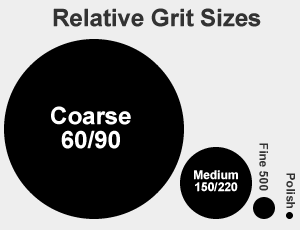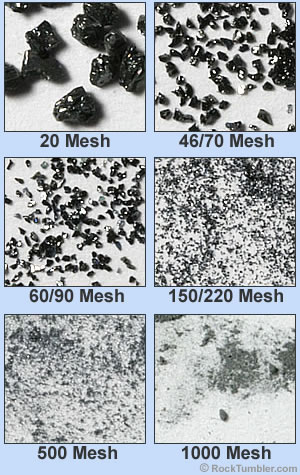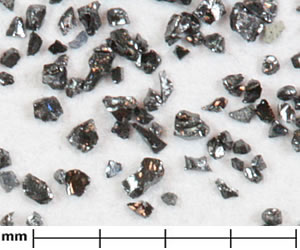What is Rock Tumbler Grit?

Most of the tumbling done in a rotary tumbler follows a four-step tumbling process. The grits used are typically coarse (60/90 grit), medium (150/220 grit), fine (500 grit), and a rock polish such as TXP aluminum oxide.
Most of the tumbling done in vibratory tumblers follows a three-step process that includes medium (150/220 grit), fine (500 grit), and a rock polish such as #61 Rapid Polish. Coarse grit is not used because it is too large to cling to the rocks during tumbling.
Most of the tumbling done in vibratory tumblers follows a three-step process that includes medium (150/220 grit), fine (500 grit), and a rock polish such as #61 Rapid Polish. Coarse grit is not used because it is too large to cling to the rocks during tumbling.
Hard, Sharp, Inexpensive Abrasive
Rock tumbler grit is a man-made silicon carbide abrasive that is sold in granules of the proper size for shaping, smoothing and polishing rocks in a tumbler. Silicon carbide is the preferred grit for rock tumbling because it has three characteristics...
- It is very hard.
- It crushes into sharp, angular particles.
- It is inexpensive.
Angular Particles: When crushed, silicon carbide breaks into angular-shaped particles with sharp points and edges. This gives it an effective cutting and grinding ability when it is caught between tumbling rocks in a tumbler barrel.
Inexpensive: Silicon carbide is inexpensive, selling for just a few dollars per pound as a screened and packaged product.
The combination of hardness, angularity and low price make silicon carbide an excellent abrasive for rock tumbling, gem cutting and lapidary work of all kinds. Silicon carbide granules are also used for sandpaper, sand blasting, water-jet cutting and many other purposes.
Synthetic Silicon Carbide
Silicon carbide occurs naturally as the mineral moissanite; however, it is extremely rare, only found in tiny quantities in a limited number of locations. All of the silicon carbide sold as an abrasive is manufactured. It is produced by placing a mixture of petroleum coke (a fuel and a carbon source) and sand (a silicon source) in an electric resistance furnace and heating to a very high temperature. The silicon carbide is then crushed and screened into specific sizes. These "grits" and "powders" are used as sandblasting, cutting, grinding and polishing media.

This image shows the relative size of coarse, medium and fine grit compared to the size of a grain of rock polish.

These photographs compare the relative sizes of several different grits. The 60/90, 150/220 and 500 grits are typically used for rock tumbling.
Most people might guess that a few tablespoons of 20 grit would provide more aggressive cutting than an equivalent amount of 60/90 grit. That is not what happens. With 20 grit there are so few particles of grit in the barrel that very little cutting gets done, but with 60/90 grit there are an enormous number of particles in the barrel and the result is surprisingly more effective.
A few people use 1000 grit between the 500 grit step and the polishing step, but most of the time this is not needed if the polishing step is allowed to run for 12 to 24 additional hours.
Most people might guess that a few tablespoons of 20 grit would provide more aggressive cutting than an equivalent amount of 60/90 grit. That is not what happens. With 20 grit there are so few particles of grit in the barrel that very little cutting gets done, but with 60/90 grit there are an enormous number of particles in the barrel and the result is surprisingly more effective.
A few people use 1000 grit between the 500 grit step and the polishing step, but most of the time this is not needed if the polishing step is allowed to run for 12 to 24 additional hours.
"Grit Sizes"
Rock tumbler grit is sold in a number of different grit sizes. The numbers used are the same as those used when selling sandpaper. Small numbers are used for the coarser grits (larger size particles), and large numbers are used for the finer grits (smaller size particles).
| grit | microns |
|---|---|
| 20 | 841 |
| 30 | 595 |
| 40 | 420 |
| 50 | 297 |
| 60 | 250 |
| 80 | 177 |
| 90 | 166 |
| 100 | 149 |
| 120 | 125 |
| 150 | 100 |
| 180 | 83 |
| 200 | 74 |
| 220 | 68 |
| 250 | 58 |
| 270 | 53 |
| 325 | 44 |
| 400 | 37 |
| 500 | 25 |
| 600 | 20 |
About Microns: A "micron" is a unit of linear measure that is 1/1,000,000th of a meter, or 1/1000th of a millimeter. That particle of 60 grit is 250 microns across or about 250/1000th or 1/4 millimeter across. They are very small, but individual grains are large enough that a person with normal vision can easily see them.
Some silicon carbide is sold as a "graded grit." That means all of the particles are very close to the same size. For example, an abrasive sold as "80 grit" would have almost all of the particles about 177 microns in size. Graded grit must be carefully crushed and screened to be sure that all of the particles are approximately the same size.
In contrast, "ungraded grit" has a wide range of particle sizes. For example, an abrasive sold as "60/90 grit" would have a range of particle sizes smaller than 60 grit (250 microns) but larger than 90 grit (166 microns). Ungraded grits do not require the same level of processing needed for graded grits. That allows ungraded grits to be sold for a lower price than graded grits.
For rock tumbling, the less expensive ungraded grit works fine and that is what most people use for the coarse and medium grit steps.
What Grit Size is Polish?
Polish has a very small particle size. Instead of talking about its "grit size" size, many people simply state its particle size in microns. Most rock tumbling polishes have a particle size of between about one and four microns. The TXP aluminum oxide polish is popular for use in rotary rock tumblers and for vibratory rock tumbling has a particle size centered on 3 microns.
Some people want a much smaller particle size for vibratory polishing. Those people might use #61 Rapid Polish. It has a particle size of about 0.3 microns and has the ability to produce a brighter polish on many materials in a vibratory tumbler.

This image is a close-up photo of 60/90 ungraded silicon carbide grit. The scale at the bottom of the photo has one millimeter increments. You can clearly see that there are a range of particle sizes as expected in an ungraded grit.
Rock Tumbler Grit Sequence
Most of the tumbling done in a rotary tumbler follows a four-step grit and polish sequence. The grits used typically begin with coarse (60/90 grit), followed by medium (150/220 grit), followed by fine (500 grit), and finished with a rock polish such as TXP aluminum oxide.
Most of the tumbling done in vibratory tumblers follows a three-step process that includes medium (150/220 grit), fine (500 grit), and a rock polish such as #61 Rapid Polish. Coarse grit is not used because it is too large to cling to the rocks during vibratory rock tumbling.
The largest particle size is used first and the smallest particle size is used last. Coarse grit does the rough shaping of the rock, the medium grit removes the scratches made by the coarse grit and produces a smoother surface, the fine grit further smooths the rock and prepares it for polishing. Polishes have an appropriate particle size to bring the rock surface to a bright luster.
These grit sizes, or similar sizes, are used by most people who do rock tumbling and many of those people experiment to find grits or methods or polishes that produce superior results with specific materials.
Using Silicon Carbide Grit
In most rotary tumblers, about two ounces (two tablespoons) of silicon carbide grit is used for each pound of rock being processed. That is the typical charge if you are going to tumble for about seven days. That much grit distributes through the barrel and does a great job at grinding the rough rocks and producing "rock mud".
The grit particles will break and wear down as they spend day-after-day in the tumbler. At the end of a week any grit that you find in the barrel will be smaller in size than when you started. If you run it long enough the grit will break into very tiny particles and be difficult to find in the barrel. That is evidence that you got your money's worth and the reason why trying to recycle grit is a waste of time. It has been spent!
Happy Tumbling!
RockTumbler.com Authors
 |
Hobart M. King has decades of rock tumbling experience and writes most of the articles on RockTumbler.com. He has a PhD in geology and is a GIA graduate gemologist. He also writes the articles about rocks, minerals and gems on Geology.com. |

